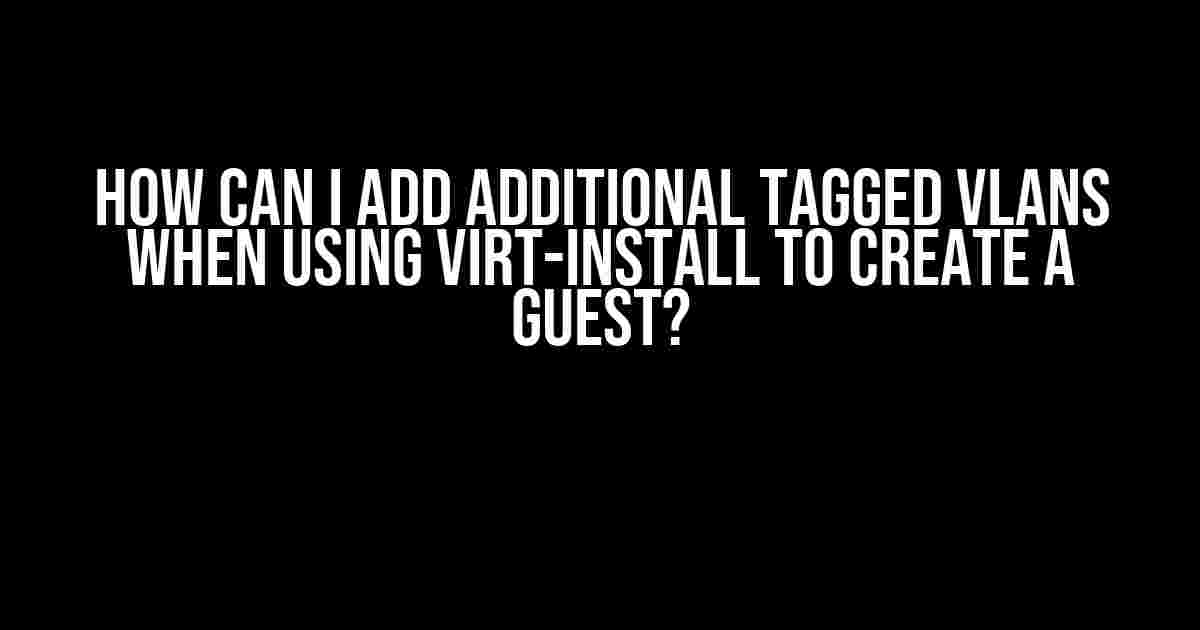Welcome to our comprehensive guide on adding additional tagged VLANs when using virt-install to create a guest! If you’re struggling to configure your VLANs, you’re in the right place. In this article, we’ll take you through a step-by-step process to help you achieve VLAN tagging with virt-install.
What are VLANs and Why Do I Need Them?
VLANs, or Virtual Local Area Networks, are a way to divide a physical network into multiple logical networks. This allows for better network management, improved security, and increased flexibility. When creating a virtual machine using virt-install, you might need to add multiple VLANs to your guest to ensure seamless communication with different networks.
Benefits of Using VLANs with Virt-Install
- Improved Network Segmentation: VLANs enable you to separate different networks, reducing the risk of network breaches and improving overall security.
- Enhanced Flexibility: With VLANs, you can add or remove networks as needed, making it easier to adapt to changing network requirements.
- Better Resource Allocation: VLANs allow you to allocate network resources more efficiently, reducing congestion and improving network performance.
Preparing Your Environment
Before we dive into the process, make sure you have the following prerequisites in place:
- A working installation of virt-install
- A physical network interface card (NIC) that supports VLAN tagging
- A basic understanding of Linux commands and networking concepts
Understanding VLAN Tagging
VLAN tagging is the process of adding a VLAN ID to an Ethernet frame. This allows the network switch to forward the traffic to the correct VLAN. There are two types of VLAN tagging:
- 802.1Q VLAN Tagging: This is the most common type of VLAN tagging, which adds a 4-byte VLAN ID to the Ethernet frame.
- : This type of tagging doesn’t add any VLAN ID to the frame, but rather relies on the switch to determine the VLAN based on the port configuration.
Adding Additional Tagged VLANs with Virt-Install
Now that we’ve covered the basics, let’s get started with adding additional tagged VLANs using virt-install!
Step 1: Create a VLAN Interface
First, create a VLAN interface on your physical NIC. You can do this using the following command:
ip link add link eno1 name eno1.10 type vlan id 10In this example, we’re creating a VLAN interface named “eno1.10” on the “eno1” NIC, with a VLAN ID of 10.
Step 2: Configure the VLAN Interface
Next, configure the VLAN interface using the following command:
ip addr add 192.168.10.1/24 brd 192.168.10.255 dev eno1.10In this example, we’re assigning an IP address of 192.168.10.1 with a subnet mask of 24 bits to the “eno1.10” interface.
Step 3: Add the VLAN Interface to the Guest
Now, it’s time to add the VLAN interface to your guest using virt-install. You can do this by specifying the VLAN interface as a network device:
virt-install \
--name myguest \
--ram 2048 \
--vcpus 2 \
--os-type linux \
--os-variant rhel7 \
--disk path=/var/lib/libvirt/images/myguest.img,size=20 \
--network network=default,model=virtio,MAC=52:54:00:00:00:10 \
--network network=vlan10,model=virtio,MAC=52:54:00:00:00:20,source=eno1.10In this example, we’re creating a guest named “myguest” with two network interfaces: one for the default network and another for the “eno1.10” VLAN interface.
Step 4: Verify VLAN Tagging
Finally, verify that VLAN tagging is working correctly by checking the output of the `ip link show` command:
ip link show eno1.10This should display the VLAN interface with the correct VLAN ID and IP address.
Troubleshooting Common Issues
If you encounter issues while adding additional tagged VLANs with virt-install, here are some common solutions:
| Issue | Solution |
|---|---|
| Error creating VLAN interface | Check that the physical NIC supports VLAN tagging and that the VLAN ID is valid. |
| VLAN interface not visible in the guest | Verify that the VLAN interface is properly configured and that the guest has the necessary drivers. |
| Network connectivity issues | Check the network configuration and verify that the VLAN ID is correct. Also, ensure that the switch is configured to forward traffic to the correct VLAN. |
Conclusion
Adding additional tagged VLANs with virt-install is a straightforward process that requires some basic knowledge of networking concepts and Linux commands. By following the steps outlined in this article, you should be able to configure your VLANs successfully and improve your network’s security, flexibility, and performance.
Remember to troubleshoot common issues and verify VLAN tagging to ensure seamless communication between your guest and the physical network.
Happy networking!
Frequently Asked Question
Get ready to virt-install like a pro! Here are the top 5 FAQs on adding additional tagged VLANs when creating a guest.
Q: Can I specify multiple VLANs using the –network option?
Yes, you can! Simply separate the VLAN IDs with commas. For example: `–network bridge=virbr0,model=virtio,vlan=100,vlan=200`. This will create a guest with interfaces on VLANs 100 and 200.
Q: How do I specify the VLAN tagging mode?
You can specify the VLAN tagging mode using the `vlan_tagged` or `vlan_trunk` options. For example: `–network bridge=virbr0,model=virtio,vlan_tagged=100,vlan_tagged=200`. This will create a guest with interfaces on VLANs 100 and 200 using tagged VLANs.
Q: Can I use –network multiple times to specify different VLANs?
Yes, you can! You can use multiple `–network` options to specify different VLANs. For example: `–network bridge=virbr0,model=virtio,vlan=100 –network bridge=virbr0,model=virtio,vlan=200`. This will create a guest with interfaces on VLANs 100 and 200.
Q: What if I want to specify a VLAN range?
You can specify a VLAN range using the `vlan_tagged` option with a range of VLAN IDs. For example: `–network bridge=virbr0,model=virtio,vlan_tagged=100-200`. This will create a guest with interfaces on VLANs 100 through 200.
Q: Are there any limitations to adding additional tagged VLANs?
Yes, there are some limitations. The maximum number of VLANs you can specify depends on the network interface model and the underlying network infrastructure. Additionally, some network interfaces may not support VLAN tagging or trunking. Be sure to check the documentation for your specific use case.
